Photographer Remembers the Firefighters at West Side House That Suffered Greatest Number of Casualties on 9/11
Photographer Peter Foley spent a year living at a mid-town firehouse in 2001 prior to 9/11. During that time, he captured casual photos and formal portraits of the men from a firehouse that would have the largest number of fatalities from a single house that tragic day 23 years ago.
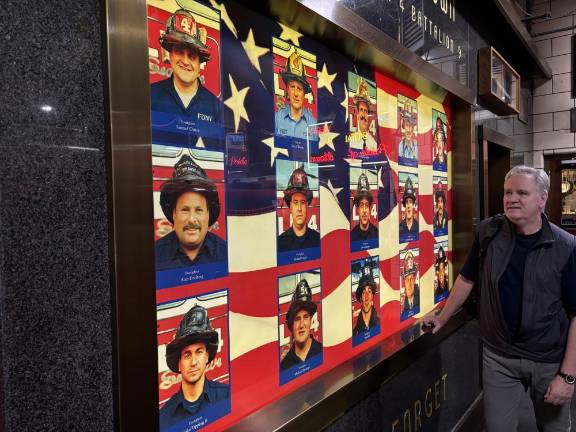
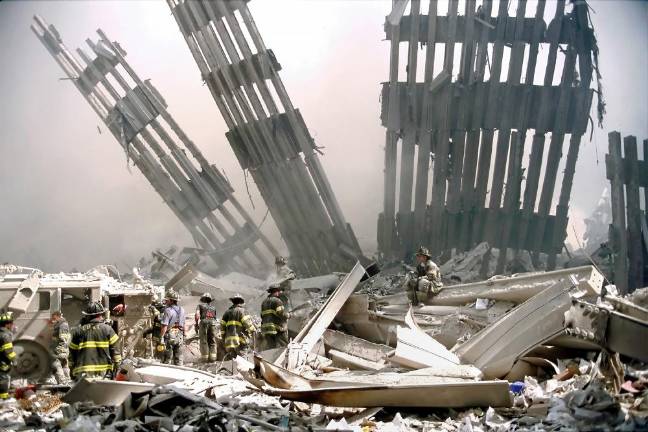
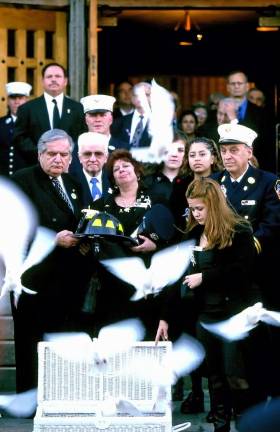
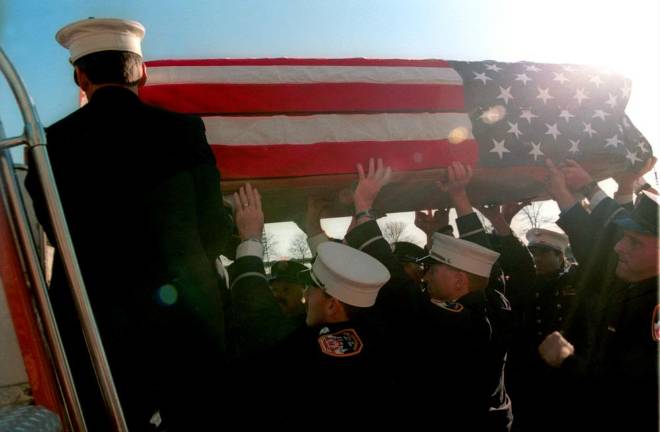
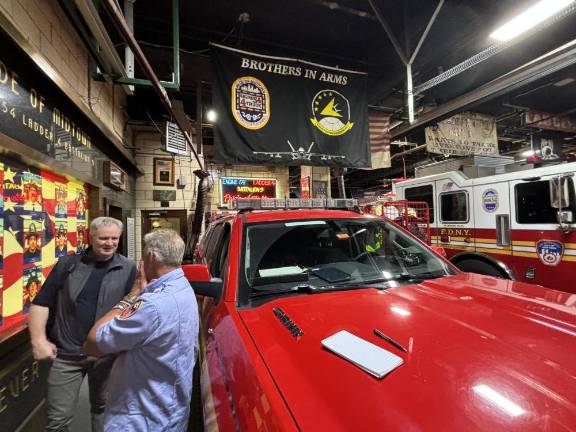
On 9/11, shortly after 8:46 a.m., fifteen firefighters from Engine Company 54, Ladder 4, Battalion 9–every man in the house that day plus one who was already on his way home– jumped on board vehicles responding to the World Trade Center attack that had begun moments earlier.
None of the men who answered the bell that morning would ever return.
Photographer Peter Foley, who had lived in the firehouse for most of the year, had captured every one of the fallen firefighters in slice of life casual photos and formal portraits during the months before the tragic day.
It would be known as the firehouse that suffered the single greatest loss of life of any firehouse in the city.
Foley said he returns to a memorial in the park around the corner from the house every year on the anniversary of 9/11, but rarely to the firehouse itself. “I don’t want to impose on these guys,” he says and adds, “none of the guys I knew are here anymore.”
A few days before 9/11 this year, he knocked on the door of the firehouse with me. “I lived here for a year before 9/11,” he said, to the probie firefighter who answered the door before Captain Robert Hauryluck agreed to let Foley inside. But the captain was careful to move Foley away from a secret service agent scouting the house before the annual 9/11 ceremonies days away.
There is now a full wall of Foley’s photos with the firefighters who died that day. “I took all of those pictures,” Foley says to the captain, a veteran of more than 30 years who was stationed in the Bronx that day and came to the west side house as a captain back in 2014.
The captain noted that the families of the fallen 15 dealt with the tragedy in different ways. Some never returned to the annual memorial services. Others would return on major anniversaries. “Some are here a lot,” Hauryluck said. One of the firefighters now in the house is a young woman whose father was killed on 9/11 and worked in that very house. “I won’t give you her name,” Hauryluck said, protective of the privacy of all the firefighters in his command. The memorial wall, hard by the engine and ladder and the racks where firefighters store their waterproff turnout gear and helmets has a sign: “no photos.”
While Foley waited outside the house, he noticed a mother with a young daughter stopped by the front of the firehouse to read the names on a plaque. “Those are the name of the firefighters who died on 9/11,” she said.
While it’s good that people remember, and they always try to be accommodating, Haurluck also said that what he calls “catastrophe tourism” can be a little wearying at times.
Foley remembers the days as if is was yesterday. He recalled how he happened to be riding his bike on the West Side when he received a call from his sister who told him to turn on the tv. “I got every roll of film I had and stuffed them into my pockets,” he said. It was the days before every photographer had high speed digital cameras and still relied on old fashioned film.
The North Tower had already fallen. “I got to 14th St. and the second tower falls,” Foley said. At one point as he grew closer, around Canal St. the debris had grown so think on the ground that he chucked his bike in an alley near the Odeon restaurant and walked the rest of the way to the pile on foot. Three days later, he went back and the chef at the restaurant still had it and returned it to him.
”On the Broadway side, it was pitch black,” recalled Foley. When he finally got to West St, he recalls, “It was lit up with the brightest sunshine.” Like most people in the city, the clear blue, cloudless sky was somrthing he’d never forget.
Foley said he made sure every family of the fallen 15 got every photo he had ever taken of their loved ones.
Foley, now 66 years old, said he came to the photojournalism later in life, in his mid-30s.
He said he embarked on his project living in the firehouse because he knew firefighters as real New Yorkers and he wanted to capture a slice of their life. “Firefighters are not talkers,” he said. “Firefighters are doers.”
Looking at the photos of the fallen 15, which were set up into a permanent memorial inside the firehouse using funds donated by Morgan Stantely, Foley says of 9/11: “It changed my life obviously. I was an unknown photographer before then. I became a pretty famous photographer after 9/11.”
He concedes, “I always felt a little bit of guilt too.”
He points to some of the figures on the wall. One, Christopher Santora fresh out of the Fire Academy, had already left, his shift was over, but when he heard the bell he returned and jumped on a truck. He had been an elementary and middle school teacher before joining the FDNY, but when his name came up for the Fire Academy, he followed in his father’s footsteps and signed up.
In his year working the house, Foley said, “These were neighborhood guys. I’d shoot them eating spaghetti.” Once on a lunch run, he got behind a deli counter and shot six firefighters ordering their big lunch sandwiches. “I gained 20 lbs the year I lived here,” he said.
He recalled after he shot all his film on 9-11, he headed back uptown. By then, the subways were running again. And so were wild rumors, that were largely unfounded. “I was hearing that London was attacked, that Paris was gone.” It was not until he got back to the Newsweek office which at the time was on W. 57th St. that he was able to sort out fact from fiction. “The lab just said, ‘give us everything you got.’ They still had labs to develop film back then.”
That evening, since the all vehicles from that house and many others were destroyed, he said the FDNY was sending city buses to the firehouses to bring firefighters to Ground Zero in the hope that they could dig through the rubble and find survivors.
When he went back to the house, he said one of the lieutenants outfitted him in a turnout jacket and fire helmet so he could be smuggled on board the bus. He said he was on the pile shooting some film before law enforcement figured out that he was not a firefighter and asked him to leave because in addition to being a rescue mission it was also a crime scene where eventually it was learned that 2,753 people had been killed in NYC, including 343 firefighters.
But then as he was being escorted off the pile, he said some other firefighters from his house spied him told him they thought they had seen some movement in another collapsed building and needed his long range camera lens to see if he could spot anything. He said he got maybe another hour of work on the pile.
He had one coda to the tragic day. In the early days of the ensuing war, he was sent as an imbedded photographer and landed on the aircraft carrier the USS Lincoln. At the time, many members of the armed forces were finding out the names of the first responders who had died on 9/11 and emblazoning their names on armed forces equipment.
He said when he stepped onto the flight deck of the USS Lincoln, a fighter jet was being readied for takeoff. On the nose of the jet was emblazoned the words, “In loving memory of Edward Geraghty.”
That was the name of the Battalion 9 chief who had allowed him to room in the west side firehouse for the better part of the year and who had perished along with his men on 9/11. Foley said he had a bracelet that had been given to him at the memorial service for Chief Geraghty months earlier. He took it off and gave it to the pilot who was about to head off on a mission.
Looking back today he said, “It changed the trajectory of my life and so many others. I lost guys I really cared about and got to know,” he said. But added, “It wiped out entire families. So many of the guys in the house were under 30 years old with their whole lives ahead of them.
Up to that day, Foley, “My life was pretty normal,” he said. “Then it was like one day of war coverage.”
And he says, “It was probably the last time that America was really united.”
”Company 54, Ladder 4, Battalion 9, it’s never far from my consciousness even 23 years later.”
“I’ll always be grateful for the kindness and graciousness of these guys. They are the real New Yorkers.”